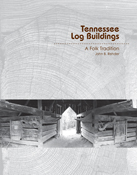Tennessee Log Buildings
A Folk Tradition

Drawing on more than four decades of research, Tennessee Log Buildings examines one of the Volunteer State’s most precious—and fast-disappearing—traditions. From the pioneer era through the mid–twentieth century, folk builders in Tennessee used logs to construct cabins, barns, other outbuildings, schools, and churches. In warm, accessible prose that often makes this deeply researched work read like guidebook, John Rehder explores the varied styles and architectural characteristics of these fascinating structures, including their floor plans, the types of timber used, and the different notches that were cut into the logs to secure the structures.
Profusely illustrated with over one hundred images, Tennessee Log Buildings traces the evolution of log houses from one-room (or single-pen) dwellings to more elaborate homes of various types, such as saddlebags, Cumberland houses, dogtrots, and two-story I-houses. Rehder discusses the historic settlement patterns and building traditions that led to this variety of house types and identifies their particular occurrences throughout the state by drawing on surveys conducted in forty-two counties by teams working for the Tennessee Historical Commission (THC). Similarly, he explores disparate barn and outbuilding types, including the distinctive cantilever barns that are found predominantly in East Tennessee. Sprinkled throughout the book are engaging anecdotes that convey just what it is like to conduct field research in remote rural areas. Rehder also describes in detail a number of the state’s exceptional log places, among them Wynnewood, an enormous structure in Middle Tennessee which dates back to the early nineteenth century and which suffered severe tornado damage in 2008.
As the author notes, many of the buildings originally identified in the THC investigations have now vanished completely while others are in serious disrepair. Thus, this book not only offers an instructive and delightful look at a key part of Tennessee’s heritage but also makes an eloquent plea for its preservation.
Until his death in 2011, JOHN B. REHDER was a professor of geography at the University of Tennessee, Knoxville. He first joined the UT faculty in 1967. He was the author of Appalachian Folkways, which won the Pioneer America Society’s Fred B. Kniffen Book Award in 2004, and Delta Sugar: Louisiana’s Vanishing Plantation Landscape, which won the Vernacular Architecture Forum’s 2000 Abbott Lowell Cummings Award.
